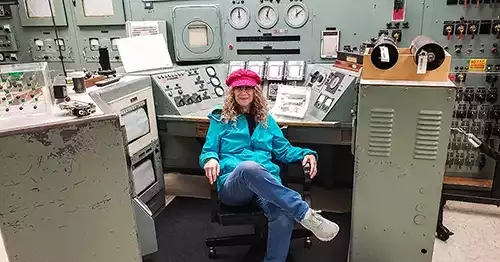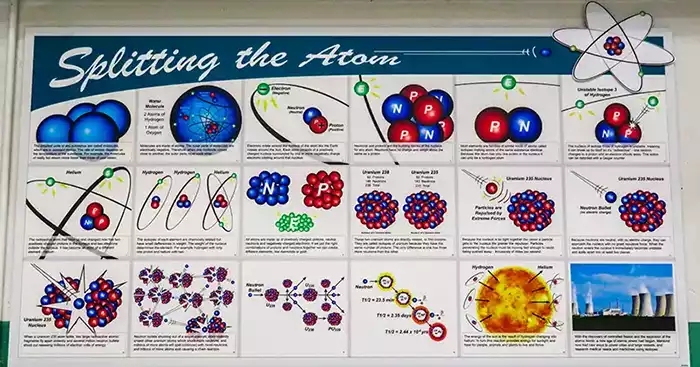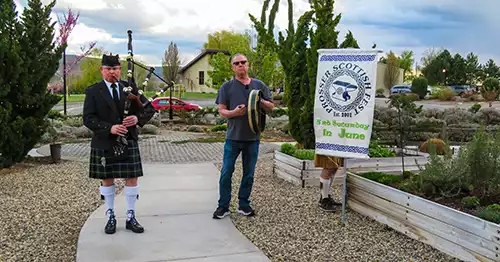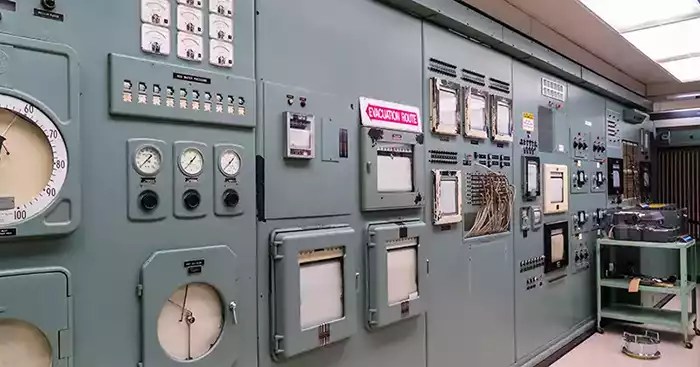The B Reactor National Historic Landmark is part of the Manhattan Project National Historical Park outside Hanford, WA. It’s operated by the U.S. Department of Energy, who give free tours of the site.
What’s in the Manhattan Project National Historical Park?
The Manhattan Project National Historical Park has two components, both with free tours from the Department of Energy: B Reactor and the Pre-War Historic Sites.
Hanford’s B Reactor was one of three locations in the Manhattan Project. Oak Ridge, TN, (produced plutonium) and Los Alamos, NM, (developed and tested the nuclear weapons) held the other two.

The reactor restarted during the Cold War from 1948 until 1968, after being shut down in 1946. In 1969 all the buildings, except B Reactor, were dismantled and removed. When it became a National Historic Landmark in 2008, the U.S. government announced that the reactor would be preserved and have public access.
Inside the reactor, things look much like they did during the years it was in operation.
Fast Fact: The front face of the reactor greets visitors when you enter, with its array of 2,004 fuel rod ports.
The tour then progresses to the Control Room for B Reactor. There, you learn how the plutonium that was in the plutonium “Fat Man” bomb, dropped on Nagasaki by a U.S. B-29 Superfortress airplane on August 9, 1945, was made.
The Pre-War Historic Sites Tour visits areas around B Reactor. The Bruggemann Ranch, displaced by the Manhattan Project, had been one of the area’s most successful farms.
Indeed it employed many people harvesting and packing a variety of fruits and vegetables.
The tour also visits the White Bluffs Bank, Hanford High School, and Allard Pumphouse.
If you can’t take a tour, you can see the former White Bluff’s Trail on the Hanford Reach National Monument.

Linda’s Pick of the Displays
The most interesting part of the tour? The science, of course, is amazing, as is the magnitude of the technology and equipment. However, my pick of the displays was the Reflection Room. It consists of three rooms: History, Atomic Culture, and Break Room.
This part of the tour is designed to help you understand what was happening in the world from WWII until the end of the Cold War. It also shows you what life was like for the employees working on Reactor B and the support workers.
Fast Fact: Safety was key here, both to protect the workers and to ensure there were no accidental nuclear chain reactions.
It took a lot of workers to run B Reactor. There were eight mess halls, each the size of a football field. Workers consumed 50 tons of food served per meal! Indeed one meal took 7200 pies, 2500 pounds of pot roast, 144,000 pork chops, or 11,000 pounds of Swiss steak. And for breaks, 30,000 donuts and 700 cases of Coke were consumed daily.

As you go through the facility, you’ll also find details about the safety equipment and daily routines of workers. Indeed, health physics was a key component of every day operations.
For example, some workers had to wear a double rain suit, which consisted of cap, hood, coveralls, raincoat, rain pants, canvas boots, waterproof gloves and rubber boots — that’s a lot to walk around in and work!
Linda’s Road Trip Tips
My road trip started in Kennewick, one of the three cities that make up Washington’s Tri-Cities area. There, I stayed at the very comfortable Red Lion Hotel Columbia Center, which was just a 10-minute walk to the Three Rivers Convention Center where I was attending a conference.
And while the B-Reactor was one of the highlights of my visit, a few dozen of us enjoyed an awesome afternoon and evening in the small city of Prosser, 35 miles from Kennewick.
Prosser is home to over 30 wineries, all located in Washington’s oldest AVA or American Viticultural Area. In other words, the region has the specific geographic and climactic features that produce the best grapes. Around 140 of the 250 AVAs in the U.S. are located in Prosser.
So, we made our way through Vintner’s Village for some amazing wine tastings along with lots of great appetizers. My favorite wine came from Airfield Estates. While our hosts were young, the family estate was founded in 1920.

They not only grow all their own grapes, they still make wine using grape-stomping! Indeed, you can even roll up your jeans and hop in the harvest bin to join in with the stomping in their public fall event.
Who Should Visit the B Reactor?
The Manhattan Project National Park B Reactor is a must see museum for everyone regardless of age. It takes you inside the technology and time period that produced the plutonium bomb, helping end WWII where between 70 – 85 million people died.

Interested in science and physics? Then you’ll find details you learn on the tour are fascinating. The secrecy around the Manhattan Project and how it was maintained is also amazing.
How To Visit the B-Reactor at Manhattan Project National Historical Park
Tours to the Manhattan Project National Historical Park B Reactor are free and open to both U.S. citizens and out of country visitors. The tours begin and end in Richland, WA (one of the Tri-Cities), so you’re transported 37.6 mi (60 km) by bus to and from the Reactor site.
Your starting point, the National Historic Office and Visitor Center, is at 2000 Logston Blvd., Richland.
Register for a tour at Manhattan Project B Reactor Tours.
Visit the B Reactor Museum Association on Facebook for the latest news.
Take a virtual tour with the National WWII Museum on YouTube.
Plan your trip with Google Maps. If you enjoyed this article, please pin it to share later.
Explore More Military & War Museums
- Excellent Military Museum: Nanaimo, BC

- Unforgettable Pacific War Museum in Texas

- Mind-blowing Cold War Aircraft at Hill Aerospace Museum

- 1942 Battleship & 1941 Submarine: Mobile, Alabama

- Incredible WWII Museum in Minnesota

- Exposing WWII’s Manhattan Project in WA

- Massive WWII Museum Collection in New Orleans

Acknowledgements
I visited the Manhattan Project and Prosser as part of a TBEX, travel blogging conference.









